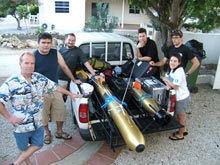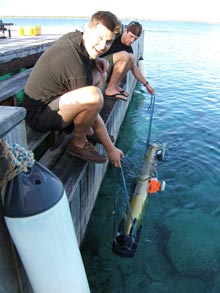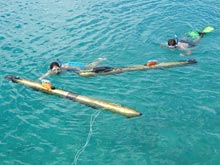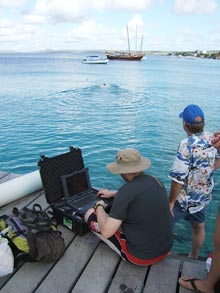Dive! Dive! Dive! AUVs Underway
The Gavia autonomous underwater vehicle (AU) team is loaded up with two robots and support equipment and bound for a day of field operations. (From left) Chris Roper, Eggert Magnusson, Richard Yeo, Art Trembanis, Alex Forrest, and Hilary Stevens. Click image for larger view and image credit.
Art Trembanis and Alex Forrest conduct trim and buoyancy testing with the UBC Gavia vehicle dockside prior to mission operations. Click image for larger view and image credit.
January 12, 2008
Arthur Trembanis
Expedition Co-principal Investigator
Assistant Professor, University of Delaware
AUV Operations and Marine Geologist
![]() The Hafmynd Gavia autonomous underwater vehicle (AUV) allows for unprecedented bathymetric sonar mapping. (Quicktime, 1.1 Mb.)
The Hafmynd Gavia autonomous underwater vehicle (AUV) allows for unprecedented bathymetric sonar mapping. (Quicktime, 1.1 Mb.)
![]() Underwater video survey of the Bonaire sea floor by the UBC Gavia AUV. (Quicktime, 1 Mb.)
Underwater video survey of the Bonaire sea floor by the UBC Gavia AUV. (Quicktime, 1 Mb.)
The last two days have seen a flurry of exciting project activity. Having been set back several days from where we had intended (owed to shipping and customs delays), the teams have all sprung into double-time action to make up for lost time.
We set our first objective on Friday to establish the proper ballast and trim for the vehicles. (Ballast refers to the overall buoyancy of the robot relative to the water, in other words is the vehicle floating too low or too high in the water.) This is a crucially important element that can often require a labor-intensive repeated trial-and-error process especially when working in a new area for the first time. In addition to ballast, another important setting is the trim of the vehicle. Trim refers to the balance of the buoyancy between the bow (forward) and aft (rear) sections of the vehicle. Too far forward and the robot will have trouble returning to the surface after a dive. Too far backward, with the nose of the vehicle pitched up, and the robot will have trouble diving to begin with.
With this simple objective in mind, we set off to the pier at Bonaire Dive and Adventure, where we were generously allowed access to their waterfront dock. We scored our first major success when we plopped the Hafmynd Gavia autonomous underwater vehicle (AUV) in the water and discovered to our surprise that her trim and buoyancy were spot on for the conditions in the local waters. In parallel effort, we split off Alex Forrest and Hilary Stevens so that they could attempt to establish the same buoyancy and trim control on the University of British Columbia (UBC) Gavia.
With trim set and all systems registering a green light for action, we played host to the arrival of the study-abroad student group from the University of Delaware. Students and local divers gathered along the dock for an impromptu lecture by Art regarding the many features and capabilities of the AUV. The lecture included a discussion of the famous test by Colladon and Sturm in 1826 to establish the speed of sound in water. That test was surprisingly accurate.
Hilary and Alex swim alongside the two Gavia AUVs, making last minute visual inspections of the robots before they are sent out to conduct simultaneous mapping of the coral reef. Click image for larger view and image credit.
Sitting at the Gavia AUV controls, Richard Yeo is about to hit the "go" button and initiate a mission to map the coral reef. Click image for larger view and image credit.
We spent the rest of the morning sending the two robots out on various missions from the shore and managed to get a whole host of new achievements in the process. This was the first time to our knowledge of any AUV operations in and around Bonaire. What made it even more special was that we had not one but two AUVs working in concert together to conduct simultaneous and complementary operations. There is an old saying that “many hands make light work” and this rings true also for AUVs as two vehicles allow us to cover twice as much ground or do twice as many different tasks.
One of our vehicles, the Hafmynd AUV carries a very special payload for this project in the form of the advanced sea-floor mapping sonar called GeoSwath Plus. This bathymetric sonar allows us to map the shape and texture of the sea floor, using sound in ways that provide unprecedented resolution of the seabed. The AUV we are using is the only one of its kind in the world configured with such an advanced mapping sensor, and we are trying to make the most of the system. Combined with the camera images, these data give us the opportunity to explore the composition and distribution of the reef structure from shallow waters of 3 to 5 meter (m)/10 to 16 foot (ft) depth down to as far as 150 m (492 ft).
We also managed to set dive depth records for the Hafmynd AUV of 120 m (394 ft); and, for the UBC team, this was their first chance to run the vehicle in an open-ocean saltwater setting.
Sign up for the Ocean Explorer E-mail Update List.






























